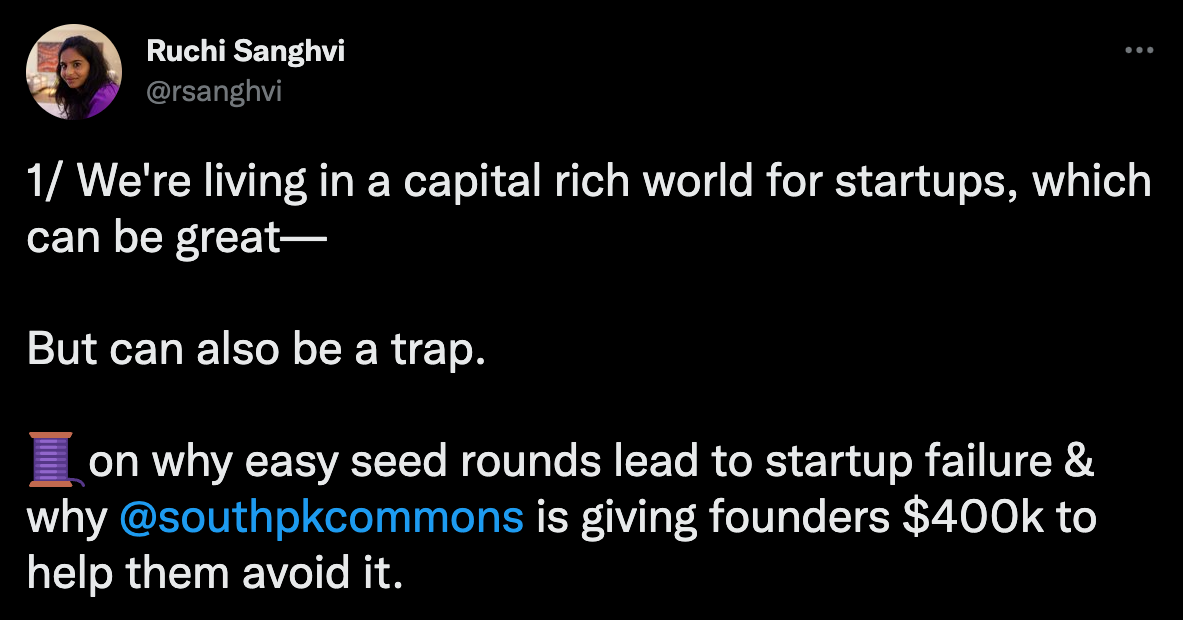The Liberating Power of Default-Dead
The funding environment has changed, but the best course of action is not the same for all founders.

You may have noticed a recent change in the economic climate. Public valuations of technology companies have cratered in response to the non-linear effects of several exogenous shocks. The bull run in equities looks finished. Private investment followed, leading to a cascade of lower valuations and truth-reckoning down the series ladder.
You may have also noticed an uptick in the number of investors offering advice, through leaks or threads or otherwise. Like any increase in product volume, this packaged wisdom comes in response to real demand. Startup founders are experiencing the most significant change in the funding environment in most of their careers. For anyone considering or already committed to the perilous journey of building a venture-scale company, it might be unnerving. Every new bit of CRITICAL ADVICE can feel like an omen of doom.
They’re not. The world is not ending. Some of the most iconic companies of our time came from the last period of economic upheaval. Great companies are still being built and will continue to be founded through whatever happens next. But things are different and it’s reasonable for a founder to wonder if they should act differently.
As an investor—and as someone who was building Facebook before and during the last major economic downturn—I have some perspective many founders don’t. Even more important, I think, is how being part of the South Park Commons community modifies that perspective. So as I join the chorus of advice, you may notice I’m a bit out of tune.
The Mandate is Survival, the Method Is...
You can summarize my perspective in three points:
- Series A and later companies—those that have gotten from 0 to 1—should listen to investor warnings and quickly adjust burn rate to prioritize survival and reaching profitability.
- Seed and pre-seed founders shouldn’t significantly change course if they have high conviction in their companies.
- If you don’t have high conviction, or you can’t convince investors to invest, now is a great time to go back into -1 to 0.
So, first, to reiterate some tough love for growth-stage companies: if you have product-market fit, what matters now is company economics. If building a startup is like assembling the plane while it’s moving, you need to figure out which modifications are needed to take off before you crash. Don’t assume you can build out more runway before reaching the end.
This is common advice right now, but it’s not groupthink. It’s math. Valuations and capital scarcity flow from public to private markets. And while I’m not as pessimistic as some about how long this downturn will last, you should assume it will last a while. If you have a path to profitability, take it. Survive.
I do not hold the same view for seed and pre-seed teams.
The Default is Dead
A critical point you need to understand is that all seed-stage and earlier companies are default dead. You don’t even have a plane yet. You showed someone the rough specs for a plane so they would let you use their runway, and now you’re sprinting down the tarmac in sneakers trying to assemble what you pitched.
I’m stretching the analogy here, but you get my point: the economics of seed stage companies don’t make any sense. Everyone is betting that they will make sense. Your concerns are fundamentally different from a later-stage company’s.
This doesn’t mean nothing has changed. Valuations are headed lower, either because investors will want more for their money or check sizes will drop. The dominos from public markets will eventually reach the smallest checks. The minimum bar for proof points will go up. But funds still have to deploy the capital committed to them and growth-stage investments look particularly risky right now. Down rounds scare investors. The nice thing about seed stage is by definition there can’t be a down round. If you have conviction and are planning to raise a seed, your plans shouldn’t change much.
It’s possible we’re headed for a more protracted downturn than I anticipate and the funding environment at seed changes more than I expect. Even then, your ability to build lasting, impactful companies won’t fundamentally change. And your tactics shouldn’t change much, either.
Here’s what this means in practice:
- There’s no point in rushing to close a round. The new parameters for proof are already in effect.
- You shouldn’t shift into a defensive posture in terms of spend if you have funding.
This second point is perhaps the most important given how often founders are likely to hear conflicting advice for growth-stage companies. You simply cannot play defensively in the earliest stages of company building. That’s playing to lose, no matter the funding environment. If you need to hire someone, delaying that hire won’t save your company but instead doom it. Spend what’s needed on consultant help for design or marketing. Don’t skimp on market or user research. Companies are like exponentials: small changes early on have massive consequences later.
Paul Graham's original point with default dead/alive was that most companies wait too long to make sure their economics are viable without additional funding. This lesson is especially important now for growth companies worrying about capital availability. But I think pre-seed and seed founders risk a lot when they risk too little. And right now they're hearing everywhere to shift into a defensive stance. Remember when that advice makes sense and when it doesn't.
You are already default dead, so there’s no point in preserving your position.
Conviction Matters More Than Ever
What the new macro situation should do is get you thinking about how much conviction you really have in what you want to build. Now is not the time to go all-in on an idea you’re only partially committed to. The funding environment of the last few years made it easy to raise money for half-assed ideas. This was a trap we at South Park Commons have been pointing out for a while. The upside of a higher bar for funding is you’re less likely to waste several years of your life on a project you’re not sure about or a product no one wants.

Instead, this is a fantastic opportunity to embrace -1 to 0. Take the time to explore and really build conviction in an idea. If investors aren’t willing to fund your company, take that as a signal to reassess. Double down on yourself and seek out environments that help you iterate and validate quickly.
The world really is different now for growth stage companies. Their founders need to make necessary and often painful adjustments. But it’s really not all that different for the pre-seed and seed stage founders who were going to succeed before. If the shifting macro environment has you doubting your company at the pre-seed stage, you never had conviction in the first place. Go back to -1 and put in the work to validate or discard the idea. If you have conviction, build aggressively and optimistically and iterate toward product-market fit. There’s no other way to do it.
That, at least, is one thing that hasn’t changed.
If now seems like a good time to embrace -1 to 0 and build conviction, consider applying to SPC!
